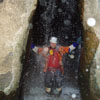Results 1 to 17 of 17
Thread: Rigging Rope
-
05-01-2009, 06:30 AM #1
Rigging Rope
It's raining aaagggghhhhh. So here's my question for today.
Rappel 90-100 ft. according to beta. Nice anchor in the wall. CANNOT see the bottom.
Group of 4 reasonably experienced.
Group of 6 with some noobs.
As far as we know it is dry at the bottom but could have a nice pool.
We have 2 120' ropes in Tom's nifty rope bags.
How are you going to set it up?
Any responses would be appreciated.
Mark
-
05-01-2009 06:30 AM # ADS
-
05-01-2009, 07:13 AM #2
You don't need ropes, just use webbing. It's easier to pack around
-
05-01-2009, 07:30 AM #3
Are you sure you want to learn about canyoneering this way? Maybe go out with some experienced people or take a class.
Since you can't see the bottom some questions. How good is the beta? If it's a well publicize trade route then I'd send an experienced person down with ability to jummar back up if something is wrong. If it's more like I think it's 100 ft type beta, I may send down he first person on a contingency anchor and ability to jummar back as well. If it's all noobs then send down the first person on a contingency anchor. Or I may start the rappel until I can varrify that it's long enough and then jummar back up and send a noob down on a contingency or belay.
As for the pool how cold is it? Do you have wetsuits/drysuits? If not cold, then be a man swim it without a wetsuit. If cold be a man and swim it without a wetsuit, or maybe put on your wetsuit. If Tanya is with you, and the anchors are strong, set up a guided rappel. There are only two acceptable reasons for a guided rappel, keeping Tanya dry is one of them.
-
05-01-2009, 08:04 AM #4
I feel I am more then qualified to handle these rappels. Isn't that what the concept behind this forum is to learn about canyoneering?

I am just interested in how other people would handle them. My question I guess would be are you dropping the bag listening for thud. Then going single keeping the other rope for emergency etc. Or feediing the rope down keeping the bag at the top setting a contingency to lower if you need to etc. Or tying them both together dropping both bags and going double? Or it just depends.
If I was concerned on the length being more then 120 I would feed one rope through anchor tie both ropes together on the down side of anchor. Drop one bag. Put contingency on other rope to lower if drop is bigger then 120'. After one is on the ground then regroup if nec.
-
05-01-2009, 09:01 AM #5
 Originally Posted by trackrunner
Originally Posted by trackrunner

I think Mark is plenty capable of handling these situations.
My guess is he is just trying to learn by seeing how others would approach the situation. I know I read these "what if's" to see if I can learn something new.... always someone around with a better idea...

-
05-01-2009, 09:38 AM #6
How i have handled it in the past. start with a rudimentary rock drop test. can tell whether or not there's water upon impact. possible to tell from tonal frequency if the the water depth is over 2 feet. fix single rope. rappel. if impasse is reached, then jug the fixed line. retreat. if passable, then have a competent member convert the fixed line to retrievable system. continue down canyon. (this is coming from a self-proclaimed intermediate-level canyoneer.)
what exactly do you mean by "noob"? i for one had developed a healthy knowledge of high-angle rope-work from my rock-climbing/big-walling days when i started out as a canyoneering noob. so, if the noobs background includes sound rope-work experience i would not be hesitent to explore. However, if your canyon companions include 1/2 dozen entry-level Boy Scouts (having been one myself) I can understand how the scenario could become trivial.
-
05-01-2009, 10:03 AM #7
I've got nothing against what if situation questions. State that's what it is. Some of the questions lately have been basic (no not all Marks).
One of the most popular threads over at the ACA forum is the "scenario" threads. People post a pic or a description of a problem and then you try to solve it. People have come up with some interesting ways on how to do a long rappel of 300ft+ with multiple lengths of rope and still get your rope back after the rappel. Doesn't mean I'm ever going to try to pass a knot on a macram
-
05-01-2009, 10:55 AM #8
The basic rule of thumb that I use is: Never trust beta!! It is not a play by play, only a resource to get you into a canyon.
When I have a drop that I can't see the bottom I always rig a contingency.
Marks idea of starting the knot on the rappel side of the rapide is spot on. It allows for a lower system that will not require passing your knot through the rapide(doable)
Seems much easier to start out in this situation pre-rigged for contingency rather than ascending back up because your rope was too short. Then setting up a contingency.
-
05-01-2009, 10:56 AM #9I'm really enjoying Mark's questions and posts. I do not have much practical experience, but I like learning the theory. I'm even getting some of the answers correctly as I play along at home.
 Originally Posted by Iceaxe
Originally Posted by Iceaxe
Don't worry, I will always travel with more experienced people and someday I hope to take a training session or two.
In the meantime, I hope Mark will continue with these questions.
-
05-01-2009, 01:17 PM #10
I have seen most of the what ifs on aca but there seems to be alot more traffic on this site.
We typically are the toss and go rappellers. We toss the bag oh let me back up we anchor the rope so we do not have to rappel on webbing then we toss the rope. We biner block it with a 6 ft tail. Keep the other rope at the top for emergencies. Last guy eithers pulls up to create pull cord or ties on the other rope and either drops or clips to his harness.
then we toss the rope. We biner block it with a 6 ft tail. Keep the other rope at the top for emergencies. Last guy eithers pulls up to create pull cord or ties on the other rope and either drops or clips to his harness.
We have never been real comfortable with sending the end down and hoping we are on the ground. A releasable anchor allows you to lower someone if the rope did not reach but we are not comfortable with taking a chance of lowering just because the rope did not reach. Yes the cool releasable with an eight is pretty sound but why take a chance when you know the bag is on the ground. The bag keeps the rope on the ground organized etc. If we have concerned rappelers we will pull up more slack and uise an eight so we could lower a little if nec. but mainly just use a biner. By keeping the other rope at the top we feel we could resolve pretty much whatever problem should arise.
If some in the group want to go double we send first guy then pull up till both ends are on the ground and then double strand rappel. Yes this does put some wear on the bags but Tom's got to make a living.
-
05-01-2009, 03:02 PM #11
Mark I think it's a good idea to keep the pull cord up top until the end for the reasons listed.
Also good so someone doesn't rig into the pull cord and tries to rappel on that over the rappel line.
If someone wants to rappel double do you still keep a "rescue rope" up tope just in case? I try to have a resuce rope up top, but will admit don't always do.
-
05-01-2009, 03:18 PM #12What is this "rescue rope" of which you speak???
 Originally Posted by trackrunner
Originally Posted by trackrunner


-
05-01-2009, 03:20 PM #13Are you sure you want to learn about canyoneering this way? Maybe go out with some experienced people or take a class.
 Originally Posted by Iceaxe
Originally Posted by Iceaxe

-
05-01-2009, 03:21 PM #14
If we can't half one rope then we tie them together and are screwed if a problem arises.We very seldom ever go double. Piranhas like to rap the rope around itself.
As far as the pull cord we NEVER drop till the last guy.
-
05-02-2009, 06:57 AM #15
Contingency anchor/lower: Munter/Mule.
Or listen to the advice of onlookers below? I was at the last drop in Heaps (275') during a "speed descent" a number of years ago. Many onlookers at the beach (south side of upper Emerald Pool.). Unfortunately a young couple was directly below on a flat rock sprawled out on their beach towell soaking the mid afternoon rays. I hollered down to politely ask that they move from under the fall zone?! My voice brought attention to the masses below that Steve and I were high above. "Hey...how did you guys get up there?"...No time to answer their curiosities..... "Please ask the couple to move out from below so that we don't accidently drop debris on them!!!!"....a brief hesitation......."Why don't you guys just go back up the way you came?!"....that one really got me thinking Anyway...the couple heard the conversation and had a premonition that maybe it would be best to move from their snuggly nest below, and no sooner than they had taken 3 steps a golf ball size rock splattered on their warm deck below! I didn't see if my rope reached, but I did know from the sound of the rock that at least it wouldn't be a wet dissconnect!
Anyway...the couple heard the conversation and had a premonition that maybe it would be best to move from their snuggly nest below, and no sooner than they had taken 3 steps a golf ball size rock splattered on their warm deck below! I didn't see if my rope reached, but I did know from the sound of the rock that at least it wouldn't be a wet dissconnect! 
-
05-02-2009, 07:10 AM #16I would block the top of one rope at the anchor with a 4' tail, and drop the bag. A solid splash or thud would indicate that the bag made it to the ground (or at least, to something solid). Then:
 Originally Posted by moab mark
Originally Posted by moab mark
A. Theoretically, I would rig a contingency anchor and send the first person down, etc. etc.
B. In the Real World, I would tie on the other rope and chuck that bag too, then Stone-Knot them at the anchor, which would give me two available ropes going down. Send down the other good guy to give bottom belays, then use both ropes to send the troops down.
Yes, I know how to tie a munter mule to set a contingency. But I also know how to do a conversion real darn quick, and can convert to a lower in less than a minute. Where is my lowering rope? It is the other strand going down. In an emergency, the other rappeller can be hurried along to free up that strand. COULD go down and help out, but ONLY if another competent "good guy" was available up top.
Tom
-
05-11-2009, 10:49 PM #17
Re: Rigging Rope
Since you are guessing it's dry at the bottom, I'm assuming it's not a class C canyon. Then, you should have communication below. Also assuming you can't really see much of the ground so you can't estimate the distance. Originally Posted by moab mark
Originally Posted by moab mark
The easiest overall method that comes to my mind would be to thread one rope (A) through the anchor. Tie the other rope (B) to the first rope (A). Set a contingency anchor on A. That way, you would have almost 240' of rope if necessary. Toss the nifty rope bag with rope B down. A thud is a good thing; but not necessarily the ground. One of the experienced folks raps down and then calls if he needs more rope. Likely, when he is down, he will call (or signals) up to set the right rope length. We just did something similar for Calf Creek over the weekend.
Assuming the beta is right, and the first person reaches the ground with the first rope; remove the contingency and tie a stone knot. Toss the other bag down, and you can alternate folks, or send them down simultaneously (depending on what the anchor looks like.)
= Or =
Depending on the source of the beta; if it's from a trusted source, just block one line a few feet from the end and toss the bag. Listen for a hit (should be able to tell the difference between ground and water.) If the person on the rope is really experienced; it really doesn't matter. He could always lock off, tie a shorter rope or a piece of webbing to the original rope to complete the rappel; and then the situation can be dealt with afterwards.
If there is water at the bottom, and the rap length is correct at 90-100ft; you could likely set up a directional so only that first rappeller has to get wet...
Similar Threads
-
Anchor Rigging Questions
By moab mark in forum CanyoneeringReplies: 4Last Post: 12-15-2009, 07:27 AM -
Which Anchor/Rigging do you usually use?
By moab mark in forum CanyoneeringReplies: 9Last Post: 12-11-2009, 01:27 AM -
Whats wrong with the the rigging?
By cookiecutter in forum CanyoneeringReplies: 32Last Post: 12-06-2009, 05:26 AM -
Rigging Quiz
By ratagonia in forum CanyoneeringReplies: 18Last Post: 09-14-2009, 04:53 AM -
[For Sale] FS: BW Canyon Rope w/Large Rope Silo
By Wasatch in forum CanyoneeringReplies: 1Last Post: 06-15-2008, 08:08 AM
Visitors found this page by searching for:
Outdoor Forum






 Reply With Quote
Reply With Quote







